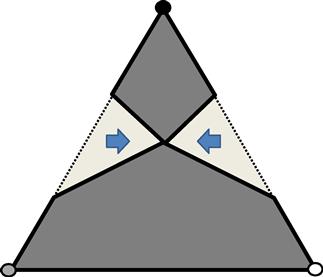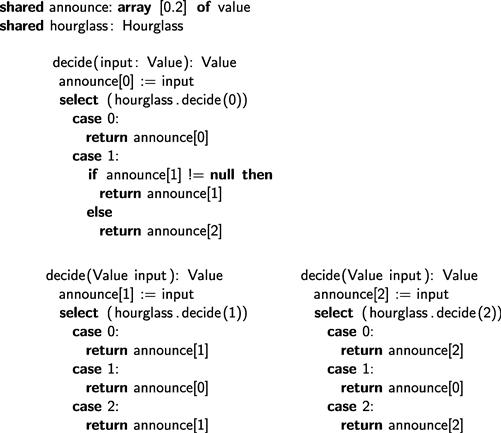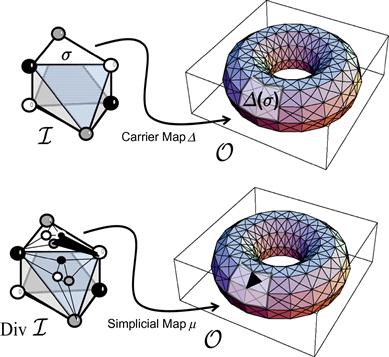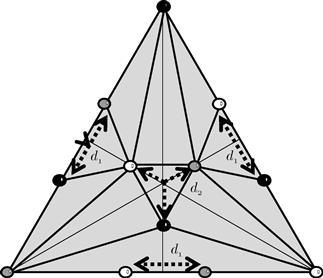Wait-Free Computability for General Tasks
Abstract
Although many tasks of interest are colorless, there are “inherently colored” tasks that cannot be defined without taking process names into account. Some have wait-free read-write protocols, and some do not. This chapter gives a characterization of wait-free read-write solvability for general tasks. We will see that general tasks are harder to analyze than colorless tasks. Allowing tasks to depend on process names seems like a minor change, but it will have sweeping consequences.
Keywords
Cauchy sequence; Lebesgue number; Chromatic subdivision; Deformation retraction; Hourglass task; Hyperplane; Link-connected; Mesh; Open cover; Safe agreement
Although many tasks of interest are colorless, there are “inherently colored” tasks that have no corresponding colorless task. Some are wait-free solvable, but not by any colorless protocol; others are not wait-free solvable. In this chapter we give a characterization of wait-free solvability of general tasks. We will see that general tasks are harder to analyze than colorless tasks. Allowing tasks to depend on process names seems like a minor change, but it will have sweeping consequences.
11.1 Inherently colored tasks: the hourglass task
Not all tasks can be expressed as colorless tasks. For example, the weak symmetry-breaking task discussed in Chapter 9 cannot be expressed as a colorless task, since one process cannot adopt the output value of another.
Theorem 4.3.1 states that a colorless task ![]() has an
has an ![]() -process wait-free layered snapshot protocol if and only if there is a continuous map
-process wait-free layered snapshot protocol if and only if there is a continuous map ![]() carried by
carried by ![]() . Can we generalize this theorem to colorless tasks? A simple example shows that a straightforward generalization will not work.
. Can we generalize this theorem to colorless tasks? A simple example shows that a straightforward generalization will not work.
Consider the following Hourglass task, whose input and output complexes are shown in Figure 11.1. There are three processes: ![]() , and
, and ![]() , denoted by black, white, and gray, respectively, and only one input simplex. The carrier map defining this task is shown in tabular form in Figure 11.2 and in schematic form in Figure 11.3. Informally, this task is constructed by taking the standard chromatic subdivision and “pinching” it at the waist to identify (that is, “glue together”)
, denoted by black, white, and gray, respectively, and only one input simplex. The carrier map defining this task is shown in tabular form in Figure 11.2 and in schematic form in Figure 11.3. Informally, this task is constructed by taking the standard chromatic subdivision and “pinching” it at the waist to identify (that is, “glue together”) ![]() ’s vertices on the edges representing its two-process executions.
’s vertices on the edges representing its two-process executions.

Figure 11.1 Input and output complexes for the Hourglass task. If a vertex ![]() is labeled with
is labeled with ![]() , then a process that chooses output vertex
, then a process that chooses output vertex ![]() in the Hourglass task chooses
in the Hourglass task chooses ![]() ’s input value for the
’s input value for the ![]() -set agreement task. Note that each triangle is labeled with at most two process names.
-set agreement task. Note that each triangle is labeled with at most two process names.
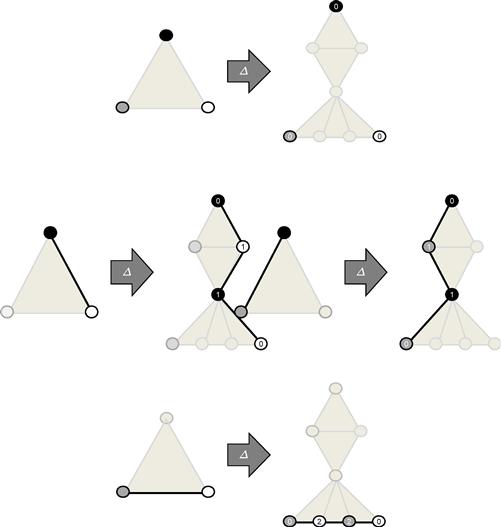
Figure 11.3 Carrier map for the Hourglass task. Single-process executions are at the top, executions for ![]() and
and ![]() on the middle left executions for
on the middle left executions for ![]() and
and ![]() on the middle right, and executions for
on the middle right, and executions for ![]() and
and ![]() on the bottom.
on the bottom.
Note that the Hourglass task satisfies the conditions of Theorem 4.3.1: There is a continuous map ![]() carried by
carried by ![]() , shown schematically in Figure 11.4.1
, shown schematically in Figure 11.4.1
Nevertheless, even though this task satisfies the conditions of Theorem 4.3.1, it does not have a wait-free layered immediate-snapshot protocol. Perhaps the simplest demonstration is merely to observe that we can solve 2-set agreement by composing a layered immediate snapshot protocol with a protocol for the Hourglass task. It follows that if we had a layered immediate snapshot hourglass protocol, then this composition would yield a layered immediate snapshot protocol for 2-set agreement, which we know to be impossible.
The composite protocol is shown in Figure 11.5. The processes share an array announce[], with one entry for each process, initially null. Process ![]() first writes its input value to announce[i]and then calls the layered snapshot Hourglass protocol. If that call returns 0,
first writes its input value to announce[i]and then calls the layered snapshot Hourglass protocol. If that call returns 0, ![]() may be running by itself, so it decides its own input. Otherwise, the processes behave differently. If the Hourglass protocol returns 1 to
may be running by itself, so it decides its own input. Otherwise, the processes behave differently. If the Hourglass protocol returns 1 to ![]() , then
, then ![]() is running concurrently with either
is running concurrently with either ![]() or
or ![]() , or both, so it decides announce[1]if it is not null ; otherwise it decides announce[2]. If the Hourglass protocol returns 1 to
, or both, so it decides announce[1]if it is not null ; otherwise it decides announce[2]. If the Hourglass protocol returns 1 to ![]() or
or ![]() , it decides announce[0]. If the Hourglass protocol returns 2, the process decides its own input. Figure 11.6 labels each output vertex with its corresponding decision value. It is easy to check that in each execution, the processes decide at most two distinct values.
, it decides announce[0]. If the Hourglass protocol returns 2, the process decides its own input. Figure 11.6 labels each output vertex with its corresponding decision value. It is easy to check that in each execution, the processes decide at most two distinct values.
Since there is no wait-free snapshot protocol for ![]() -set agreement, there cannot be a wait-free snapshot protocol for the Hourglass task. Why does Theorem 4.3.1 fail to hold for colored tasks? One direction still works: Given a protocol
-set agreement, there cannot be a wait-free snapshot protocol for the Hourglass task. Why does Theorem 4.3.1 fail to hold for colored tasks? One direction still works: Given a protocol ![]() solving the task
solving the task ![]() , it is easy to extend the proof of Theorem 4.3.1 to exploit the connectivity of the snapshot protocol complex to construct a continuous map
, it is easy to extend the proof of Theorem 4.3.1 to exploit the connectivity of the snapshot protocol complex to construct a continuous map ![]() . Composing this map with the decision map yields a continuous map
. Composing this map with the decision map yields a continuous map ![]() carried by
carried by ![]() .
.
The other direction fails. Given a continuous map ![]() carried by
carried by ![]() , it is possible to construct a simplicial approximation
, it is possible to construct a simplicial approximation ![]() carried by
carried by ![]() , but that simplicial approximation may not be color-preserving. In other words, one process may be assigned another’s output value. Such flexibility is not an issue with colorless tasks, where by definition a process’s inputs and outputs do not depend on its identity. By contrast, for tasks such as weak symmetry breaking or Hourglass, an output legal for one process may not be legal for another.
, but that simplicial approximation may not be color-preserving. In other words, one process may be assigned another’s output value. Such flexibility is not an issue with colorless tasks, where by definition a process’s inputs and outputs do not depend on its identity. By contrast, for tasks such as weak symmetry breaking or Hourglass, an output legal for one process may not be legal for another.
11.2 Solvability for colored tasks
Recall that a simplex ![]() is chromatic if each vertex is labeled with a distinct color, and a chromatic subdivision
is chromatic if each vertex is labeled with a distinct color, and a chromatic subdivision ![]() is a subdivision of
is a subdivision of ![]() where
where
(1) each simplex of the subdivision is chromatic,
(2) for each ![]() , each vertex in
, each vertex in ![]() is labeled with a color from
is labeled with a color from ![]() .
.
We are now ready to state our main theorem.
Theorem 11.2.1 is depicted schematically in Figure 11.7. The figure’s top half shows how a task is specified by a carrier map ![]() that takes each simplex
that takes each simplex ![]() of the input complex
of the input complex ![]() to a subcomplex
to a subcomplex ![]() of the output complex
of the output complex ![]() . The bottom half shows how the simplicial map
. The bottom half shows how the simplicial map ![]() maps each simplex of a chromatic subdivision
maps each simplex of a chromatic subdivision ![]() to a simplex in the output complex such that every
to a simplex in the output complex such that every ![]() is carried to a simplex in
is carried to a simplex in ![]() .
.
It is impossible to build such a color-preserving simplicial map for the Hourglass task because the “pinch” in the middle makes it impossible for any simplicial map to be color-preserving.
In Chapter 10 we saw that the (colorless) consensus task has no wait-free layered immediate snapshot protocol. We can illustrate how Theorem 11.2.1 works by relaxing the consensus task’s requirements as follows:
Quasi-Consensus Each of ![]() and
and ![]() is given a binary input. If both have input
is given a binary input. If both have input ![]() , then both must decide
, then both must decide ![]() . If they have mixed inputs, then either they agree or
. If they have mixed inputs, then either they agree or ![]() may decide
may decide ![]() and
and ![]() may decide 1 (but not vice versa).
may decide 1 (but not vice versa).
Figure 11.8 shows the input and output complexes for the quasi-consensus task. Note that quasi-consensus is not a colorless task. Does it have a wait-free read-write protocol?
It is easy to see that there is no color-preserving simplicial map carried by ![]() from the input complex to the output complex. The vertices of input simplex
from the input complex to the output complex. The vertices of input simplex ![]() map to
map to ![]() and
and ![]() , but there is no single output simplex containing both vertices. Nevertheless, there is a map satisfying the conditions of the theorem from a subdivision
, but there is no single output simplex containing both vertices. Nevertheless, there is a map satisfying the conditions of the theorem from a subdivision ![]() of the input complex. If input simplex
of the input complex. If input simplex ![]() is subdivided as shown in Figure 11.9, then it can be “folded” around the output complex, allowing input vertices
is subdivided as shown in Figure 11.9, then it can be “folded” around the output complex, allowing input vertices ![]() and
and ![]() to be mapped to their counterparts in the output complex.
to be mapped to their counterparts in the output complex.
Figure 11.10 shows a simple protocol for quasi-consensus. If ![]() has input 0 and
has input 0 and ![]() has input 1, then this protocol admits three distinct executions: one in which both decide
has input 1, then this protocol admits three distinct executions: one in which both decide ![]() , one in which both decide
, one in which both decide ![]() , and one in which
, and one in which ![]() decides 0 and
decides 0 and ![]() decides 1. These three executions correspond to the three simplices in the subdivision of
decides 1. These three executions correspond to the three simplices in the subdivision of ![]() , which are carried to the edges
, which are carried to the edges ![]() , and
, and ![]() .
.
11.3 Algorithm implies map
One direction of Theorem 11.2.1 is straightforward: If ![]() solves
solves ![]() , then the protocol’s simplicial decision map
, then the protocol’s simplicial decision map
![]()
is color-preserving and carried by ![]() . On the other hand, any wait-free layered immediate snapshot protocol complex
. On the other hand, any wait-free layered immediate snapshot protocol complex ![]() is a chromatic subdivision of the input complex
is a chromatic subdivision of the input complex ![]() .
.
11.4 Map implies algorithm
Assume we are given a task ![]() , a chromatic subdivision
, a chromatic subdivision ![]() of the input complex, and a color-preserving simplicial map
of the input complex, and a color-preserving simplicial map ![]() carried by
carried by ![]() . We will show that this task has a wait-free read-write protocol.
. We will show that this task has a wait-free read-write protocol.
Our strategy is to show there exists a color-preserving simplicial map
![]()
for some ![]() such that for all
such that for all ![]() . These maps compose as follows:
. These maps compose as follows:
![]()
Here is how to turn these maps into a protocol. From an input simplex ![]() , each process performs the following three steps:
, each process performs the following three steps:
step 1. execute an ![]() -layer immediate snapshot protocol, halt on a vertex
-layer immediate snapshot protocol, halt on a vertex ![]() of the simplicial complex
of the simplicial complex ![]() ,
,
It is easy to check that all processes halt on the vertices of a single simplex in ![]() . Moreover, because all maps are color-preserving, each process halts on an output vertex of matching color.
. Moreover, because all maps are color-preserving, each process halts on an output vertex of matching color.
Because the identity map ![]() is continuous, it has a simplicial approximation
is continuous, it has a simplicial approximation ![]() carried by
carried by ![]() (Theorem 3.7.5). Unfortunately, there is no guarantee that this map is color-preserving. To provide such a guarantee, we will prove the following generalization of the Simplicial Approximation theorem:
(Theorem 3.7.5). Unfortunately, there is no guarantee that this map is color-preserving. To provide such a guarantee, we will prove the following generalization of the Simplicial Approximation theorem:
Both ![]() and
and ![]() are abstract complexes, defined in purely combinatorial terms. Nevertheless, we do not know how to prove the existence of this map in a combinatorial way. Instead, we will work with geometric complexes, embedded in high-dimensional Euclidean space, where we can exploit tools provided by point-set topology. Henceforth, all simplices and complexes will be geometric unless explicitly stated otherwise, so we will not always distinguish between a simplex or complex and its polyhedron. The exact meaning should be clear from context.
are abstract complexes, defined in purely combinatorial terms. Nevertheless, we do not know how to prove the existence of this map in a combinatorial way. Instead, we will work with geometric complexes, embedded in high-dimensional Euclidean space, where we can exploit tools provided by point-set topology. Henceforth, all simplices and complexes will be geometric unless explicitly stated otherwise, so we will not always distinguish between a simplex or complex and its polyhedron. The exact meaning should be clear from context.
11.4.1 Basic concepts from point-set topology
Recall that geometric simplices “live” in a a Euclidean space of high but finite dimension. Any such space is a metric space, where the distance between points ![]() and
and ![]() is denoted
is denoted ![]() . The open
. The open ![]() -ball
-ball ![]() around a point
around a point ![]() is the set of points
is the set of points ![]() such that
such that ![]() for some
for some ![]() . An
. An ![]() -ball is an open set.
-ball is an open set.
A Cauchy sequence is an infinite sequence of points ![]() with the property that the distance between successive points
with the property that the distance between successive points ![]() limits to zero.
limits to zero.
The set of points that can be expressed as affine combinations of points ![]() ,
,
![]()
where ![]() , is called the hyperplane defined by those points. If a hyperplane is generated by
, is called the hyperplane defined by those points. If a hyperplane is generated by ![]() affinely-independent points, then it has dimension
affinely-independent points, then it has dimension ![]() . A set of points need not be affinely independent to define a hyperplane, so a hyperplane generated by
. A set of points need not be affinely independent to define a hyperplane, so a hyperplane generated by ![]() arbitrary points has dimension at most
arbitrary points has dimension at most ![]() .
.
As long as a finite set of hyperplanes does not fill up the entire space, any point has arbitrarily small neighborhoods that include points not on any hyperplane.
Moreover, any point not on any hyperplane has arbitrarily small neighborhoods that do not intersect the hyperplane.
The following fact is the basis for the Simplicial Approximation theorem used in earlier chapters.
11.4.2 Geometric complexes
In Chapter 9, we defined the standard chromatic subdivision ![]() in a purely combinatorial way, as an abstract simplicial complex. Now we give an equivalent definition of
in a purely combinatorial way, as an abstract simplicial complex. Now we give an equivalent definition of ![]() as a geometric complex.
as a geometric complex.
See Figure 11.11.
For any sufficiently small value of ![]() , it can be shown that this definition gives a geometric construction for the chromatic subdivision. We will use this construction for the remainder of this section. Since all simplices and complexes in this section are geometric, we will not distinguish between an abstract vertex
, it can be shown that this definition gives a geometric construction for the chromatic subdivision. We will use this construction for the remainder of this section. Since all simplices and complexes in this section are geometric, we will not distinguish between an abstract vertex ![]() and the point
and the point ![]() or an abstract simplex
or an abstract simplex ![]() and its polyhedron
and its polyhedron ![]() .
.
Recall (Definition 3.6.7) that the mesh of a complex is the maximum diameter of any simplex.
By taking sufficiently large ![]() can be made arbitrarily small.
can be made arbitrarily small.
11.4.3 Colors and covers
To construct a color-preserving simplicial map from ![]() to
to ![]() , we will need the vertex colors to “align” nicely. More specifically, the open stars of the vertices in a
, we will need the vertex colors to “align” nicely. More specifically, the open stars of the vertices in a ![]() form an open cover for
form an open cover for ![]() . This open-star cover has a natural coloring inherited from the coloring of
. This open-star cover has a natural coloring inherited from the coloring of ![]() . The open-star cover of
. The open-star cover of ![]() is chromatic on
is chromatic on ![]() if every simplex of
if every simplex of ![]() is covered by open stars of vertices of a simplex in
is covered by open stars of vertices of a simplex in ![]() of matching color:
of matching color:
![]()
for some ![]() where
where ![]() .
.
We will show that without loss of generality, the geometric realization of ![]() can be chosen so that its open-star cover is chromatic on any iterated standard chromatic subdivision of
can be chosen so that its open-star cover is chromatic on any iterated standard chromatic subdivision of ![]() .
.
Figure 11.12 shows how an open-star covering can fail to be chromatic. Simplices of ![]() are shown with dotted lines and square vertices, whereas simplices of
are shown with dotted lines and square vertices, whereas simplices of ![]() are shown with solid lines and round vertices. The gray vertex marked
are shown with solid lines and round vertices. The gray vertex marked ![]() lies on the boundary between two gray open stars, so it is not covered by an open star of the same color.
lies on the boundary between two gray open stars, so it is not covered by an open star of the same color.
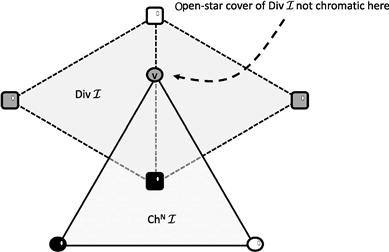
Figure 11.12 How an open-star covering can fail to be chromatic. Simplices of ![]() are shown with dotted lines and square vertices; simplices of
are shown with dotted lines and square vertices; simplices of ![]() are shown with solid lines and round vertices. The gray vertex marked
are shown with solid lines and round vertices. The gray vertex marked ![]() lies on the boundary between two gray open stars, so this open-star covering fails to be chromatic.
lies on the boundary between two gray open stars, so this open-star covering fails to be chromatic.
Note, however, that if we perturb some of the square vertices by an arbitrarily small amount, then ![]() moves off the boundary and into the open star of a vertex of matching color. This observation suggests a strategy: We will pick an arbitrary geometric realization of
moves off the boundary and into the open star of a vertex of matching color. This observation suggests a strategy: We will pick an arbitrary geometric realization of ![]() , and if its open-star cover fails to be chromatic, then we will “perturb” vertex positions by very small amounts until the open-star cover becomes chromatic.
, and if its open-star cover fails to be chromatic, then we will “perturb” vertex positions by very small amounts until the open-star cover becomes chromatic.
Readers willing to accept Lemma 11.4.10 can skip directly to Section 11.4.4.
We can recast some familiar concepts in terms of convex combinations. Every point ![]() in the polyhedron of a complex
in the polyhedron of a complex ![]() can be expressed uniquely as the convex combination of the vertices of a simplex
can be expressed uniquely as the convex combination of the vertices of a simplex ![]() of
of ![]() . The open star
. The open star ![]() is just the set of points that can be expressed as the convex combination of the vertices of a simplex that includes
is just the set of points that can be expressed as the convex combination of the vertices of a simplex that includes ![]() .
.
In this definition and in the subsequent lemmas, ![]() and
and ![]() may be replaced by arbitrary chromatic subdivisions. Two simplices conflict if they share no colors.
may be replaced by arbitrary chromatic subdivisions. Two simplices conflict if they share no colors.
Corollary 11.4.13 follows because the definition of conflict point is symmetric in terms of the two subdivisions.
We say that ![]() has an
has an ![]() -perturbation at vertex
-perturbation at vertex ![]() for some
for some ![]() if there is a point
if there is a point ![]() , such that replacing
, such that replacing ![]() with
with ![]() in each simplex of
in each simplex of ![]() yields a subdivision
yields a subdivision ![]() isomorphic to
isomorphic to ![]() . (This isomorphism means that both complexes are geometric realizations of the same abstract complex.) See Figure 11.13. For brevity, we write such a perturbation as:
. (This isomorphism means that both complexes are geometric realizations of the same abstract complex.) See Figure 11.13. For brevity, we write such a perturbation as:
![]()
If ![]() is the result of applying
is the result of applying ![]() -perturbations at multiple vertices, we write:
-perturbations at multiple vertices, we write:
![]()
We will see that there is always an ![]() such that any vertex of a
such that any vertex of a ![]() can be perturbed to any position within
can be perturbed to any position within ![]() within its carrier.
within its carrier.
Because ![]() and its perturbation
and its perturbation ![]() are just different geometric realizations of the same abstract complex, we have completed the proof of Lemma 11.4.10.
are just different geometric realizations of the same abstract complex, we have completed the proof of Lemma 11.4.10.
11.4.4 Construction
We are now ready to prove Theorem 11.4.1, showing there exists a color-preserving simplicial map
![]()
such that for all ![]() ,
, ![]() .
.
We will construct a sequence of chromatic subdivisions, ![]() , for
, for ![]() , where
, where ![]() , along with a sequence of simplicial maps
, along with a sequence of simplicial maps
![]()
defined on ![]() , except for a subcomplex
, except for a subcomplex ![]() of dimension at most
of dimension at most ![]() .
.
At the end of the sequence, ![]() is empty, so
is empty, so
![]()
is the desired map.
This sequence of subdivisions induces a parent map,
![]()
carrying each vertex of ![]() to the unique vertex of matching color in its carrier in
to the unique vertex of matching color in its carrier in ![]() . The ancestors of a vertex
. The ancestors of a vertex ![]() are the vertices
are the vertices ![]() .
.
Subdividing ![]() induces subdivisions on its subcomplexes. Given a subcomplex
induces subdivisions on its subcomplexes. Given a subcomplex ![]() , define
, define ![]() to be the maximal subcomplex of
to be the maximal subcomplex of ![]() satisfying
satisfying ![]() . Similarly, for
. Similarly, for ![]() , define
, define ![]() to be the maximal subcomplex of
to be the maximal subcomplex of ![]() satisfying
satisfying ![]() .
.
For the base case of our construction, let ![]() , and
, and ![]() is everywhere undefined.
is everywhere undefined.
For the inductive step, assume we are given ![]() and
and ![]() for all
for all ![]() .
.
Lemma 11.4.10 states that we may assume, without loss of generality, that the open-star cover of ![]() is chromatic for
is chromatic for ![]() , including
, including ![]() , the subcomplex where
, the subcomplex where ![]() is undefined. Let
is undefined. Let ![]() be the Lebesgue number of this cover of
be the Lebesgue number of this cover of ![]() . Pick
. Pick ![]() large enough that for every facet
large enough that for every facet ![]() of
of ![]() ,
,
![]() (11.4.1)
(11.4.1)
We will use this inequality later.
We define ![]() as follows: Each vertex
as follows: Each vertex ![]() in
in ![]() not in
not in ![]() “inherits” the map from its parent:
“inherits” the map from its parent: ![]() . Otherwise, for each vertex in
. Otherwise, for each vertex in ![]() , if there exits a vertex
, if there exits a vertex ![]() such that
such that
![]() (11.4.2)
(11.4.2)
and ![]() , then
, then ![]() .
.
The remaining vertices of ![]() define
define ![]() , the subcomplex of
, the subcomplex of ![]() where
where ![]() is not defined. Note that this definition implies that for
is not defined. Note that this definition implies that for ![]() ,
,
![]() (11.4.3)
(11.4.3)
Lemma 11.4.20 states that the vertex map
![]()
is color-preserving and simplicial, whereas Lemma 11.4.21 states that ![]() is empty. Together these imply that
is empty. Together these imply that
![]()
is a color-preserving simplicial map.
This completes the proof of the “map implies algorithm” direction of Theorem 11.2.1.
It is useful to observe that the “property implies protocol” part of the proof assumes only that the model of computation in which the protocol is constructed is strong enough to solve the immediate snapshot task.
Of course, the converse of this corollary does not hold in general.
11.5 A sufficient topological condition
We now give a simple topological condition that ensures that a colored task ![]() has a wait-free read-write protocol. We will use the following topological property.
has a wait-free read-write protocol. We will use the following topological property.
The output complex for the Hourglass task shown in Figure 11.1 is not link-connected, since the vertex at the hourglass’s “waist” is disconnected, that is, not 0-connected.
This theorem establishes the existence of a protocol in terms of the topological properties of complexes and carrier maps.
By Theorem 11.2.1, it is enough to prove the following lemma.
We need the following lemma about link connectivity.
We make use of the following fact, discussed in the chapter notes.
We are now ready to complete the proof of Lemma 11.5.3 (and hence Theorem 11.5.2). For ![]() , we inductively construct a sequence of chromatic subdivisions
, we inductively construct a sequence of chromatic subdivisions ![]() and a color-preserving simplicial map
and a color-preserving simplicial map
![]()
carried by ![]() .
.
For the base case, let ![]() send any vertex
send any vertex ![]() of
of ![]() to any vertex of
to any vertex of ![]() . This construction is well-defined because
. This construction is well-defined because ![]() is
is ![]() -connected (non-empty) by hypothesis. This map is trivially color-preserving.
-connected (non-empty) by hypothesis. This map is trivially color-preserving.
For the induction hypothesis, assume we have constructed a chromatic subdivision and color-preserving simplicial map
![]()
This simplicial map induces a continuous map that sends the boundary of each ![]() -simplex
-simplex ![]() in
in ![]() to
to ![]() . By hypothesis,
. By hypothesis, ![]() is
is ![]() -connected, so this map of the
-connected, so this map of the ![]() -sphere
-sphere ![]() can be extended to a continuous map of the
can be extended to a continuous map of the ![]() -disk
-disk ![]() :
:
![]()
These extensions agree on ![]() , so together they define a continuous map,
, so together they define a continuous map,
![]()
where for each ![]() ,
, ![]() .
.
Note that the restriction of ![]() on the
on the ![]() skeleton is just
skeleton is just ![]() , a color-preserving simplicial map, so by Lemma 11.5.6, there is a subdivision
, a color-preserving simplicial map, so by Lemma 11.5.6, there is a subdivision ![]() of
of ![]() such that
such that ![]() and a rigid simplicial map
and a rigid simplicial map ![]() extending
extending ![]() . By Lemma 11.5.7,
. By Lemma 11.5.7, ![]() is also color-preserving. These extensions agree on the
is also color-preserving. These extensions agree on the ![]() -skeleton, so together they define a color-preserving simplicial map:
-skeleton, so together they define a color-preserving simplicial map:
![]()
carried by ![]() .
.
When ![]() is a color-preserving simplicial map carried by
is a color-preserving simplicial map carried by ![]() , completing the proof.
, completing the proof.
By analogy with Corollary 11.4.22, the proof of Theorem 11.5.2 requires only that the protocol model support the immediate snapshot.
One interesting and useful fact that emerges from this discussion is that if two different read-write models with different adversaries have the same minimal core size, then they solve the same set of colorless tasks. In this sense, an adversary’s minimum core size completely determines its computational power for colorless tasks.
11.6 Chapter notes
The results in this chapter originally appeared in Herlihy and Shavit [91].
Herlihy, Rajsbaum, and Raynal [87] present an implementation of the safe agreement task in a layered model. See Exercise 11.1.
Mostefaoui, Rajsbaum, and Raynal [122] and Mostefaoui, Rajsbaum, Raynal, and Travers [121] study “condition-based” variations of tasks such as consensus in which the input complexes are restricted to permit ![]() -resilient layered snapshot protocols. Such tasks provide simple, natural examples of colored tasks, where processes can adopt one another’s output values but not their input values.
-resilient layered snapshot protocols. Such tasks provide simple, natural examples of colored tasks, where processes can adopt one another’s output values but not their input values.
Imbs, Rajsbaum, and Raynal [95] study generalized symmetry-breaking tasks (GSB) that include election, renaming, and other tasks that are not colorless. These are fixed-input in the sense that the only input to a process is its name.
Fact 11.5.5 is Theorem IV.2 of Glaser [72].
1This map is a deformation retraction, a continuous deformation of the input complex’s polyhedron into the output complex’s polyhedron that leaves the output complex unchanged.


